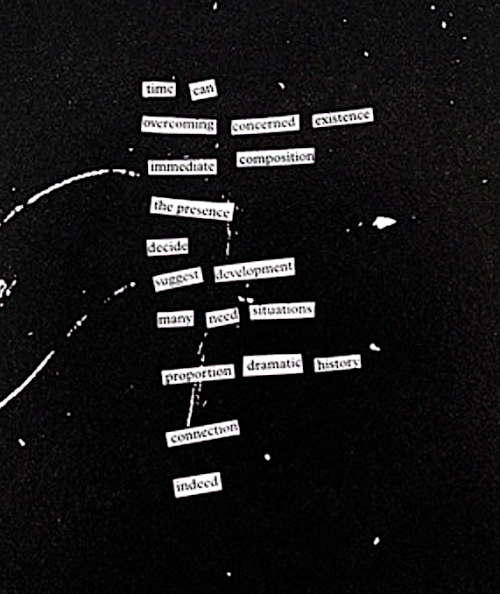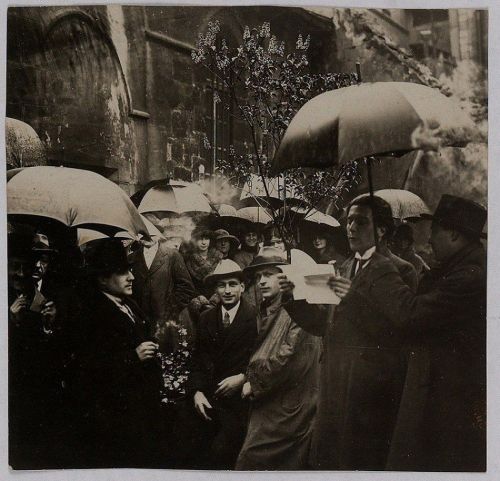#tristan tzara
Elina Brotherus (FL, 1972)

To make a dadaist poem / Take a newspaper. / Take a pair of scissors. / Choose an article as long as you are planning to make your poem. / Cut out the article. / Then cut out each of the words that make up this article and put them in a bag. / Shake it gently. / Then take out the scraps one after the other in the order in which they left the bag. / Copy conscientiously. / The poem will be like you.
https://www.elinabrotherus.com/photography#/regle-du-jeu/
Post link
Tristan Tzara, Paul Eluard, Andre Breton, Hans Arp, Salvador Dali, Yves Tanguy, Max Ernst, Rene Crevel, and Man Ray.
Post link
A Game Plan: The terms of Surrealism
“Take a newspaper.
Take some scissors.
Choose an article of the length
you wish your poem to have.
Cut out the article.
Then cut out carefully each of the words in
the article and put them in a bag.
Shake gently.
Then pull out each cutting one after the other.
Copy them down conscientiously
in the order in which they left the bag.
The poem will resemble you.
And you will be a writer of infinite originality and of
charming sensitivity, although incomprehensible to the masses”.
- Tristan Tzara.
Hannah Höch
1) “Cut with the Kitchen Knife through the Last Weimar Beer-Belly Cultural Epoch in Germany”, 1919-1920, photomontage and collage with watercolor, 114 x 90 cm.
Post link
Christian Schad, Schadograph, 1919
Although cameraless photography had been used since the birth of the medium, it was largely abandoned until the early 20th century, when it was re-invigorated by such figures as Christian Schad, László Moholy-Nagy, and Man Ray. This renewed interest is most often attributed to Man Ray in 1922, but the artist Christian Schad had been using the photogram process for his Dada-inspired work since 1919.
Schad was known primarily as a painter and proponent of Neue Sachlichkeit prior to his brief involvement in Zurich Dada in the late 1910s. In true Dada fashion, he took the photogram out of the realm of traditional art subjects by placing such detritus as scraps of paper and fabric onto light-sensitive paper, resulting in his so-called Schadographs. The name Schadograph was coined by Dada leader Tristan Tzara, as a play on both the artist’s name and ‘the shadowlike character of the pictures’ (Experimental Vision, p. 9).
photo and note from Sotheby’s
Catalogue : 175 Masterworks To Celebrate 175 Years Of Photography: Property from Joy of Giving Something Foundation (Sotheby’s, 11-12 Dec. 2014)
Post link

TheWholeDaDaistManifesto on a
Buffalo
Shoe
100 Years ago today…
“On 14 April 1921 in Paris, at three in the afternoon, in the rain, eleven Dadaists conducted a ‘lay pilgrimage’ to the church of Saint-Julien-le-Pauvre, the first in a proposed series of urban excursions to the 'banal places’ of the city…
We don’t know which of the Dada artists had suggested that site — “an abandoned church, known to few people, surrounded at the time by a sort of terrain vague enclosed by fences" — nor the reasons behind the choice. But its position, in the heart of the Latin Quarter, seems to indicate that this particular garden around a church was selected precisely as if it were an abandoned garden near one’s own home: a space to investigate, familiar hut unknown, seldom visited hut evident, a banal, useless space which like so many others wouldn’t really have any reason to exist. The exploration of the city and the continuing discovery of situations to investigate is possible anywhere, even in the heart of Parisian tourism zones, even along the Seine on the rive gauche facing the cathedral of Notre Dame.”
Francesco Careri, Walkscapes: Walking As An Aesthetic Practice, 2017.
Image:Tristan Tzara, Excursions & visites DADA, 1ère visite: Église Saint Julien le Pauvre, 1921.
Post link







